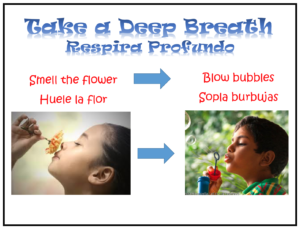
Have you ever told your crying child to “Take a Deep Breath” to help them calm down? I know I have, but unfortunately the results are either my child hyperventilating trying to take deep breaths (which ultimately frustrates him more than calms him down) or he will flat out ignore me as if I am speaking a foreign language. Not the results I was looking for.
So how can you teach a child to “Take a Deep Breath” in a way that will actually help calm them down?
Let’s first start with “Why” we should be teaching our child breathing as a calming tool.
Researchers at Stanford University School of Medicine and the University of California have identified 175 brain cells which spy on the breath and alter state of mind accordingly. The study findings suggest that it is indeed possible to reverse engineer your mood simply by altering breathing. The neurons which link breathing to relaxation, attention, excitement and anxiety are located deep in the brainstem. As you breathe deeply, neurons report “calm breathing” and tell the body it is time to relax. Stress responses (increased heart rate, fast shallow breathing, and high blood pressure) decrease. Which indeed proves that something as simple as “Deep Breathing” can be a powerful tool to ease stress, make you feel less anxious and overall can calm and regulate your body.
So now that we know “Why” this is such a great tool, HOW do we teach our child to do it effectively?
What I have found is that using “imagery” and “imagination” is a great and fun way to teach your child Deep Breathing. Here are a couple examples that have worked for me in the past:
“Hot Coco Smell and Blow”

For any type of Deep Breathing strategy, the goal is always “slow in through your nose, slow out through your mouth”. To help kids remember this and keep it fun, I have them imagine they are smelling hot yummy hot cocoa and then blowing on it to cool it down. Try it yourself! Pause for a second and imagine your favorite hot liquid – coffee, tea, soup – once the imagery is there, you can pretend to hold the cup or bowl, and now “slowly smell it in through your nose, and then slowly blow to cool it off out through your mouth. Not bad right?
“Smell the Flower, Blow Bubbles”
Same concept as above, just have your child use a finger near their nose to imagine they are smelling the flower, and then slowly imagine they are holding a bubble wand and blow out bubbles. I like this one because ALL kids love blowing bubbles, and in order for them to blow big bubbles, they know they have to do it slowly and gently.
I have also used this differently when my child is super upset and not wanting to listen to me, I will grab some bubbles myself and start slowly blowing them to distract them, usually very quickly THEY want a turn themselves and I let them and reinforce in order to make a lot of bubbles they need to breathe slowly and gently.
In the end, no matter what creative imagery you use, teaching your child how to Deep Breathe to calm and regulate their emotions is a skill they can use their entire lives, even as adults! So take the time now, while they are young, to model and teach this amazing (and free!) tool that requires no materials and can be used anywhere, as it will benefit them for years and years to come!
